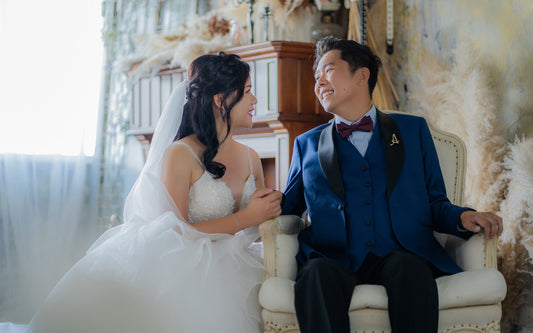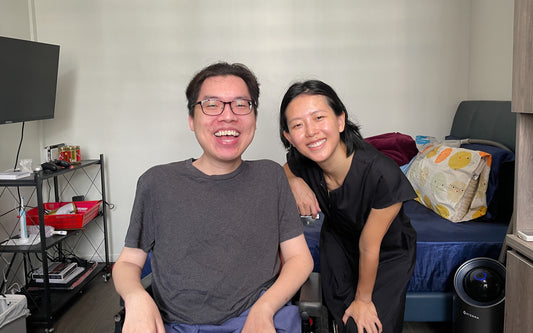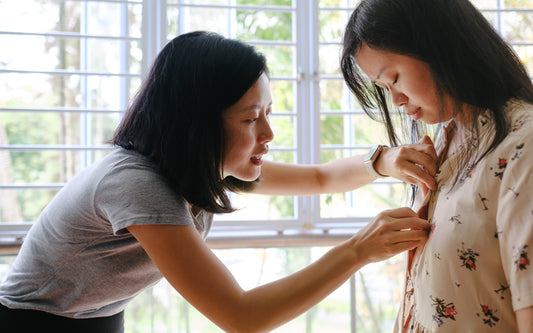

Making Fashion Inclusive | TODAY
SINGAPORE — For most people, fashion conjures up images of conspicuous, captivating articles of clothing donned by models strutting down the runway. Three LASALLE graduates are looking to change that — with their concept of inclusive fashion.
The trio designed a line of garments suitable for both wheelchair and non-wheelchair users for their final-year project, and they are looking at commercialising it.

“You’d think if clothing were such a big issue for so many people worldwide, there would be more companies providing functional, fashionable options,” said fashion design and textiles graduate Elisa Lim, 23.
“Unfortunately, this is not the case, and that is unacceptable.”
So, she roped in fellow fashion design and textiles student Ethrisha Liaw, and fashion media and industries student Caroline Justine to work on a project to build an inclusive community through fashion.
They showcased eight sets of clothing in their 1000MPH line at their school last Thursday, the result of eight months of research prototyping and consultations.
To ensure their designs were truly functional, they worked with participants from different organisations, including Cerebral Palsy Alliance Singapore, Muscular Dystrophy Association Singapore, Society for the Physically Disabled and SG Enable, and tested three prototypes before arriving at their final design.
Special features in the garments include a horizontal zip at the back of dresses and pants to give those who spend long hours sitting greater comfort, magnets instead of buttons for easier fastening, and open-ended zips sewn upside-down for easier dressing and undressing.
Natural fibres, with anti-bacterial and odourless properties, and cotton are used for greater breathability to prevent heat rash and pressure sores. Swarovski pearls and crystals are also embedded onto gloves and different parts of the garments for “textural play” and “therapeutic massage”.
“We have beads at very subtle areas, and our users can fiddle with them because they are sewn in a way that allows them to be played with,” said Ms Liaw.
The 23-year-old, who also consulted traditional Chinese medicine practitioners and therapists for the project, said the crystals and pearls “help to massage, unblock the qi (energy), and is related to the release of endorphins”. They also “serve as a direct and physical way to ground anxiety”.
Their project was initially met with great scepticism, even from their lecturers. “They were just very worried that we will make hospital clothing, because in adaptive fashion, the tendency is that everything becomes too functional and the fashion aspects are removed,” said Ms Justine, 22.
So, the trio had to strike a balance between what users wanted and what they wanted as fashion designers.
As Ms Liaw put it: “It’s really about balancing between being striking and subtlety — how you make the garments look good on stage, but are (still) something (the users) are comfortable with being seen in.”
The unusual idea was Ms Lim’s brainchild, the result of an earlier project she was involved in two years ago where she helped a doctor design clothing for bedridden patients.
It sparked her interest in designing for the disabled as there is a “real need” waiting to be fulfilled. One story that struck a chord with her was hearing an accountant tell her that the most difficult part of her day is using the washroom as a wheelchair user.
So, she knew going into her final year of studies that she wanted to push fashion further to make it inclusive. And she got Ms Liaw and Ms Justine to help. While the trio wanted to make the garments easy for wheelchair users to wear, they also wanted to make it appealing to all.
“This journey taught me that limitations are good, because then you would know what is truly important, and what you can, alas, forgo,” Ms Liaw said.
After a successful showcase last Thursday, where they received positive feedback for their collection, including expressions of interest from the voluntary welfare organisations they had worked with, they are working on making the collection available for sale.
“We will start from here (Singapore), and ideally reach out to South-east Asia and then to where it can lead us to,” said Ms Lim.
“The business will still be about inclusive community. It’s about clothing for me, for you, for them.”
–



